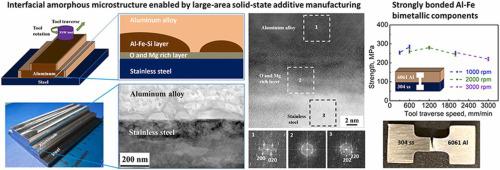Journal of Materials Processing Technology ( IF 6.7 ) Pub Date : 2022-07-16 , DOI: 10.1016/j.jmatprotec.2022.117721 F.C. Liu , P. Dong , A.S. Khan , K. Sun , W. Lu , A. Taub , J.E. Allison

|
There is a growing demand for the ability to manufacture large-scale aluminum-steel (Al-Fe) bimetallic components for realizing the enormous advantages of advanced multi-material structures which offers effective lightweighting and increasingly smart functionalities. The formation of brittle intermetallic compounds (IMCs) at the bonding interface has been the major barrier to safety-critical applications with existing manufacturing processes, including additive manufacturing techniques. This study showed that a combination of a novel modified friction stir additive manufacturing (M-FSAM) and pre-processing surface polishing of the stainless steel enables the formation of a relative homogenously distributed nanoscale amorphous layer along the bonding interface between the 6061 Al and the 304 stainless steel. As a result, the high interfacial bonding strength of 280 MPa was achieved. Compared to the existing friction stir welding/AM processes, M-FSAM enables a significant increase in tool traverse speed and a remarkable reduction in tool cost for Al-Fe bimetallic component manufacturing. The nanoscale amorphous layer consisted of a continuous O and Mg rich layer 10–20 nm in thickness and a discontinuous Al-Fe-Si layer 50–100 nm in thickness. The O and Mg rich layer consisted of an amorphous matrix with nanocrystalline precipitates while the Al-Fe-Si layer consisted of a q-glass with some degree of crystallinity. The formation mechanism of the unique Al-Fe interfacial microstructure was analyzed in detail in this study.
中文翻译:

通过大面积固态增材制造技术实现 Al-Fe 双金属组件的非晶界面微观结构和高结合强度
对制造大型铝钢 (Al-Fe) 双金属组件的能力的需求不断增长,以实现先进的多材料结构的巨大优势,提供有效的轻量化和日益智能的功能。在键合界面形成脆性金属间化合物 (IMC) 一直是现有制造工艺(包括增材制造技术)的安全关键应用的主要障碍。这项研究表明,将新型改进的搅拌摩擦增材制造 (M-FSAM) 和不锈钢的预处理表面抛光相结合,能够沿着 6061 Al 和304不锈钢。因此,实现了280 MPa的高界面结合强度。与现有的搅拌摩擦焊/AM 工艺相比,M-FSAM 能够显着提高刀具移动速度并显着降低铝铁双金属部件制造的刀具成本。纳米级非晶层由厚度为 10-20 nm 的连续富 O 和 Mg 层和厚度为 50-100 nm 的不连续 Al-Fe-Si 层组成。富含 O 和 Mg 的层由具有纳米晶沉淀物的无定形基质组成,而 Al-Fe-Si 层由具有一定结晶度的 q-玻璃组成。本研究详细分析了独特的Al-Fe界面微观结构的形成机制。M-FSAM 可显着提高刀具移动速度并显着降低 Al-Fe 双金属部件制造的刀具成本。纳米级非晶层由厚度为 10-20 nm 的连续富 O 和 Mg 层和厚度为 50-100 nm 的不连续 Al-Fe-Si 层组成。富含 O 和 Mg 的层由具有纳米晶沉淀物的无定形基质组成,而 Al-Fe-Si 层由具有一定结晶度的 q-玻璃组成。本研究详细分析了独特的Al-Fe界面微观结构的形成机制。M-FSAM 可显着提高刀具移动速度并显着降低 Al-Fe 双金属部件制造的刀具成本。纳米级非晶层由厚度为 10-20 nm 的连续富 O 和 Mg 层和厚度为 50-100 nm 的不连续 Al-Fe-Si 层组成。富含 O 和 Mg 的层由具有纳米晶沉淀物的无定形基质组成,而 Al-Fe-Si 层由具有一定结晶度的 q-玻璃组成。本研究详细分析了独特的Al-Fe界面微观结构的形成机制。富含 O 和 Mg 的层由具有纳米晶沉淀物的无定形基质组成,而 Al-Fe-Si 层由具有一定结晶度的 q-玻璃组成。本研究详细分析了独特的Al-Fe界面微观结构的形成机制。富含 O 和 Mg 的层由具有纳米晶沉淀物的无定形基质组成,而 Al-Fe-Si 层由具有一定结晶度的 q-玻璃组成。本研究详细分析了独特的Al-Fe界面微观结构的形成机制。











































 京公网安备 11010802027423号
京公网安备 11010802027423号